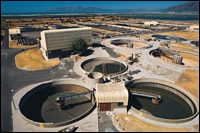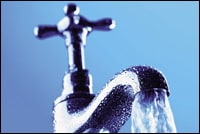NOTICE: This web page has been archived for historical purposes. Its content is no longer maintained, so information may be out of date and links may not work properly. For current Healthy Water features, please see the Newsroom, Features, & Observances page.
Drinking Water Week 2010: "Only Tap Water Delivers"
 People use water every day to meet their domestic, industrial, agricultural, medical, and recreational needs. Access to public water sources that are safe and reliable is crucial for the health and prosperity of a society.
People use water every day to meet their domestic, industrial, agricultural, medical, and recreational needs. Access to public water sources that are safe and reliable is crucial for the health and prosperity of a society.
May 2–8, 2010 is National Drinking Water Week. This observance is sponsored each year by the American Water Works Association (AWWA) and a number of other organizations and agencies, including the U.S. Environmental Protection Agency (EPA). Following the theme "Only Tap Water Delivers," the goal of National Drinking Water Week is to highlight the importance of tap water and bring attention to the need to reinvest in our nation's public water infrastructure (1).
Making Tap Water Safe and Healthy
Tap water not only provides Americans with water for daily activities (like drinking, bathing, and cooking), but also is used to deliver fluoride (to reduce the potential for tooth decay).

Incidence of Typhoid Fever, 1920-1960. With the implementation of disinfection methods for drinking water, there has been a drastic decline in cases of typhoid fever in the United States. Image Credit: Robert Tauxe. Click to view larger chart.
During the past century, many improvements in the health, prosperity, and longevity of the U.S. population can be attributed to improvements in water quality. Water treatment, disinfection, and fluoridation have made U.S. tap water one of the safest and healthiest drinking water supplies in the world (2).
In 1908, Jersey City, New Jersey, was the first city in the United States to begin routine disinfection of a municipal drinking water supply (3). Over the next decade, thousands of cities and towns across the United States began disinfecting their drinking water. This disinfection led to a dramatic decrease in cases of waterborne illness (diseases spread through water) and death.
For example, in 1900 there were approximately 100 cases of typhoid fever for every 100,000 persons living in the United States (4). In 2006, the rate had declined to 0.1 cases for every 100,000 persons (only 353 cases of illness in total) and approximately 75% —or 265 cases—occurred among international travelers (5). Adding fluoride to our tap water has also helped reduce the amount of tooth decay experienced by the public. Both the disinfection and fluoridation of public water systems are among the greatest public health achievements of the 20th century (6, 7).
Protecting Tap Water from Contaminants
As a result of environmental regulations, such as the Clean Water Act (passed in 1972), many sources of water pollution—particularly sewage—have been reduced over the years. However, treating water to remove or kill disease-causing contaminants is still critical. Contamination of drinking water sources can occur at multiple points, including in the source water, through inadequate water treatment, in storage tanks, and in drinking water distribution systems (the pipes that carry water to homes, businesses, schools, and other buildings).
 The EPA sets maximum concentration levels for many water pollutants and regulates drinking water quality in public water systems, including community water systems. Every public water utility is required to provide its customers with an annual consumer confidence report (CCR). This report gives information on local drinking water quality, including the water's source, the levels of contaminants found in the water, if any problems with the water treatment system occurred, and how customers can get involved in protecting their drinking water.
The EPA sets maximum concentration levels for many water pollutants and regulates drinking water quality in public water systems, including community water systems. Every public water utility is required to provide its customers with an annual consumer confidence report (CCR). This report gives information on local drinking water quality, including the water's source, the levels of contaminants found in the water, if any problems with the water treatment system occurred, and how customers can get involved in protecting their drinking water.
Drinking Water and Private Wells
EPA regulations that protect public drinking water systems do not typically apply to small water systems or privately owned wells. As a result, millions of Americans who get their water from these sources are responsible for ensuring that their water is safe from contaminants. A local health department or well water system professional can provide assistance on well maintenance, new well construction, and water quality testing. Visit CDC's Private Ground Water Well page.
The Future of Tap Water
Although the United States has one of the safest drinking water supplies in the world, new challenges require us to continue to work to protect our water supply. A primary concern is the fact that our drinking water infrastructure, which includes the pipes that bring water to our homes, is aging (up to 100 years old in some cases!) and needs to be upgraded or replaced. Cracked pipes, water main breaks, and other age-related infrastructure issues increase the risk for water contamination and can lead to boil water advisories. Other challenges include climate change impacts on water availability and quality, chemical and toxin contamination of water sources, and the emergence of new ways to obtain and use water.
The Centers for Disease Control and Prevention (CDC) works to address these drinking water challenges through its water-related research, prevention, and policy activities and programs, which include:
Health Impacts
 Estimating the number of illnesses and costs associated with waterborne disease and outbreaks.
Estimating the number of illnesses and costs associated with waterborne disease and outbreaks. - Providing support for health officials to investigate, report, and prevent illnesses associated with drinking water systems.
- Identifying the health impacts of climate change, aging drinking water infrastructure, and well water usage to develop strategies for improvement.
- Identifying and analyzing environmental factors that contribute to waterborne disease.
- Developing improved laboratory methods for sampling, testing, and monitoring water quality.
Policy and Public Outreach
 Working with EPA and others to provide guidance on drinking water policy and research priorities.
Working with EPA and others to provide guidance on drinking water policy and research priorities. - Developing a National Well Data Repository to support public health decision-making for well water.
- Applying study findings to improve waterborne disease prevention outreach, education, policies, and practices.
- Providing national leadership on community water fluoridation practice.
Collaboration and Partnerships
- Supporting EPA and other partners in performing their duties and responsibilities related to protecting national drinking water.
- Guiding the planning, implementation, and evaluation of programs that promote water safety.
- Strengthening the collaboration among epidemiology, laboratory, and regulatory programs to prevent waterborne disease
More Information
Podcasts about Keeping Drinking Water Safe
- A Minute of Health with CDC [PODCAST - 59 seconds]
- A Cup of Health with CDC [PODCAST - 4:36 minutes]
Public drinking water quality and your local drinking water
- CDC — Healthy Water Website
- EPA — Consumer Confidence Reports (CCR)
- EPA — What Contaminants May Be Found in Drinking Water?
- EPA — Office of Ground Water and Drinking Water
How to protect and improve well water quality
- CDC — Private Well Owners
- CDC—Fluoridation and Wells
- EPA — Private Drinking Water Wells
- USGS—Well Water Quality Report
Other drinking water and health-related resources
- CDC — Water-Related Environmental Public Health
- CDC — Index of Water-Related Topics
- CDC — Community Water Fluoridation
- CDC — Surveillance for Waterborne Disease and Outbreaks Associated with Drinking Water and Water not Intended for Drinking – United States, 2005-2006
References
- American Water Works Association. Drinking Water Week 2010.
- US Environmental Protection Agency. Drinking water and health: what you need to know.
- US Environmental Protection Agency. The history of drinking water treatment [PDF - 375 KB].
- Centers for Disease Control and Prevention. Achievements in public health, 1900–1999: safer and healthier foods. MMWR 1999; 48(40): 905 [PDF - 290 KB].
- Centers for Disease Control and Prevention. Summary of notifiable diseases- United States, 2006. MMWR 2008; 55(53): 17 [PDF - 1.42 MB].
- Centers for Disease Control and Prevention. Achievements in public health, 1900-1999: changes in the public health system. MMWR 1999; 48(50):1141-1147.
- Centers for Disease Control and Prevention. Achievements in public health, 1900-1999: changes in the public health system. MMWR 1999; 48(12); 241-243.
Get email updates
To receive email updates about this page, enter your email address:
Contact Us:
- Centers for Disease Control and Prevention
1600 Clifton Rd
Atlanta, GA 30333 - 800-CDC-INFO
(800-232-4636)
TTY: (888) 232-6348 - Contact CDC–INFO
 ShareCompartir
ShareCompartir
 Water is the foundation for life. Learn more about the tap water you use every day and why investing in our public water systems is essential to the future of safe drinking water!
Water is the foundation for life. Learn more about the tap water you use every day and why investing in our public water systems is essential to the future of safe drinking water! 

